Adapted from a press conference held at the Japan National Press Club on June 17

If we were to draw a picture of the rapid advancement of scientific technology and economic progress, and the bountiful society that has been created as a result, I imagine that would look something like the right-hand side of the image shown below. People driving cars, using computers, farming in the fields... And amidst all this, a mother and her child living happily and peacefully.
What I would like to talk about today is how this mother and her child are, when stripped bare, truly the living creatures we know as humans. Humans belong to the biological family Hominidae. We have the chimpanzees, gorillas, orangutans, bonobos... and then, came the humans. At first glance, the primates seem to be our close relatives. If we take a look at both of our DNA, we see that a difference of only a few percent separates us. That is how close we are to one another.
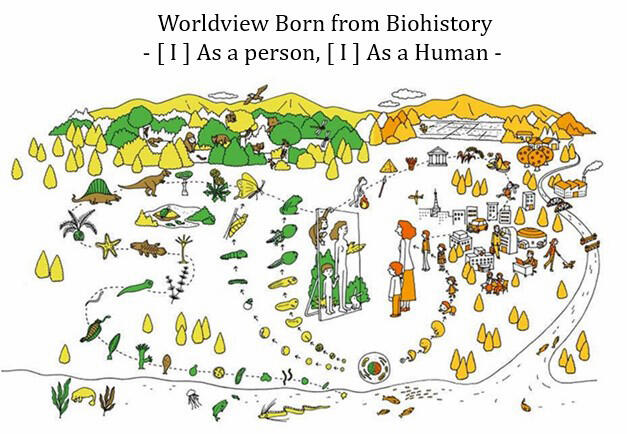
There is much to learn from the world of living things
The ancestral cells that existed eons ago, evolved and differentiated, giving rise to the living creatures around us today. Among these myriad lifeforms, only humans, born to the common ancestors of chimpanzees and primitive humans, have become able to walk on two legs. This ability made us unique in the animal kingdom. Humanity has built pyramids and cultivated civilizations. And yet, we have much to learn from the world of living things. The fact that we live only in the world represented in the right half of this drawing (a world of humans alone) breaks my heart.
Many of us have started to talk about the "post-corona" world. Perhaps some of you believe that we will fight and defeat the coronavirus and be able to return to a life without its presence. In truth, the coronavirus is but another virus that we share with the other living things in this world. From here onward, we must learn to live while being aware of the existence of such viruses. Our task is to devise clever, intelligent ways of living under such circumstances.
Like all life on this planet, we humans are nothing more than complicated collections of carbon compounds. The proteins, sugars, fats, and DNA molecules inside us are also all carbon compounds. The same is true of the food we eat. Plants use the energy of the sun to create these carbon compounds from carbon dioxide and water. Plants even make oxygen for us to breathe. When we say "decarbonization" today, what we mean is that "We produce too much carbon dioxide; we need to reduce our emissions." However, because we are also made of carbon compounds, "decarbonization" seems to imply the decarbonization of our very selves.
Carbon compounds, also known as organic compounds, are the most fundamental building blocks of the living world. From the point of view of living things, we say "decarbonization" because we care only about carbon dioxide emissions. However, because the world of life exists because of a cycle of carbon compounds, of which we are but a part, I believe the word "decarbonization" itself fundamentally misrepresents our true intentions.
Life began 3.8 billion years ago in the oceans of the world. Sometime later, cyanobacteria, capable of performing photosynthesis, emerged. Photosynthesis is not yet possible with human technology. It is extremely strange that such organisms were born in the natural world. I truly believe that photosynthesis is an impressive feat. Of course, it is very important for us to strive to achieve artificial photosynthesis, but we must recognize that this is quite a difficult goal.
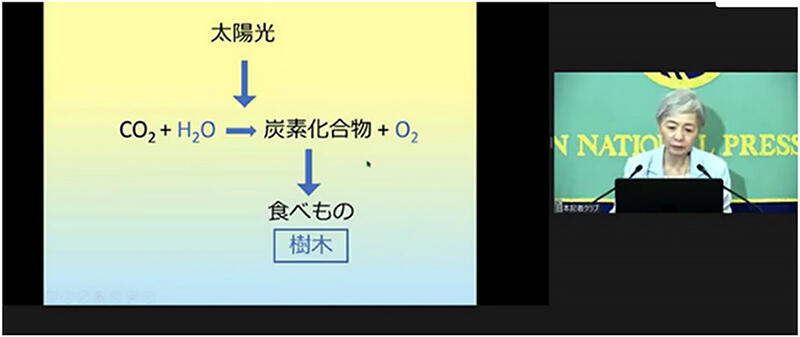
Insects comprise 70% of living species
Tropical forests absorb CO2 in the air and use it to produce O2. I think all of us recognize how important these forests are. These forests are home to many, many kinds of trees. Among them, there is a tree known as the "key plant" in Japanese. This "key plant" bears fruit year-round. The Japanese character for "forest" is written with three "tree" characters, but forests are not made up of only trees. Animals and birds and other living things are also part of the forests they live in. Insects also play a major role in keeping forests alive. Fruits like figs are the favorite food of the animals, birds, and insects that live in forests. These kinds of fruits are a very important part of tropical forests.
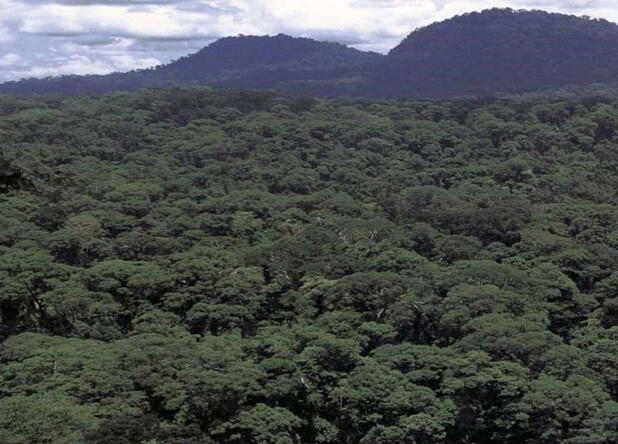
If you ever find a wild fig, try splitting it open. I almost guarantee that you will find a wasp inside. A tiny little wasp, no more than 2 mm long. Because they are so often found inside figs, these small wasps are called "fig wasps." Figs are very nutritious, making them a suitable place for these wasps to lay their eggs and raise their offspring. Of the wasps born inside these figs, only female wasps emerge from the holes you see here. Male wasps born inside these figs bore tiny holes in the fruit, making it possible for the females to escape. Then, they die.
When we study the biology related to this phenomenon, we always feel sorry for the male wasp. As the female escapes from the fig, it brings pollen along with it. In this way, the fig is both a fruit and a flower. The male wasp helps the female to escape the fruit, and the from this the fig is able to spread.
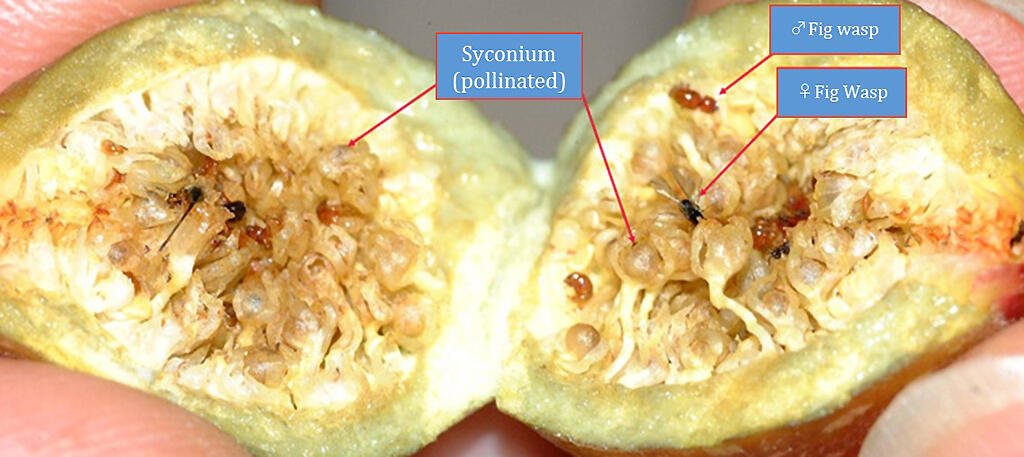
When forest fires occur and all trees in the forest are burnt down, fig trees are often the first trees to grow back. They are very, very, important trees. Trees like these are what make forests such bountiful places. From this point of view, it can be said that these 2 mm wasps create and support large forests with tens of billions of trees. We plant tens of thousands of trees, which is a daunting task for sure, but these tiny little wasps nonchalantly create and sustain entire forests--from that perspective, they are truly interesting creatures indeed.
Seventy percent of the more than 10 million species we know of are believed to be insects. Plants are the next most common type of living thing. The relationship between trees and insects serves as the foundation for all living things. We humans must live our daily lives amidst a world created by other living creatures. In the process, we should skillfully create new ways of life, new human-like technologies. I believe that as living beings, humans can and should live in such a manner.
The living world is full of surprises
Engineering is logical. It can be predicted with statistics and probabilities. But living things are unpredictable. We rarely know what they will do, or when they might do it. I think that this "unpredictability" is a very interesting feature of organisms. We often refer to things as "full of surprises." I think that the world of life is, in the truest sense of the word, full of surprises. One might call it "bricolage," where this and that and other things are all brought together to create something totally new.
Our technology is also becoming increasingly novel. Computer technology becomes newer and more advanced with each passing day. Nowadays, we tend to think of "old stuff" as "not good." However, I think the system of photosynthesis, which has been in use for more than 3 billion years, is far better than any computer technology we have today. Moreover, the system of using DNA to create our bodies is shared by both humans and bacteria. New capabilities may have been added, but the basics have not changed. For 3.8 billion years, these basics have been kept constant and have remained unchanged. Life does not throw away old things. The basics that underlie every living thing have ceaselessly spun forth ever new things (lifeforms), from bacteria all the way to humans.
I think our society should also look past mere novelty, and allow the magic, the "interesting-ness" of the things spun from the fabric of life, to inspire us and teach us to live on. I hope that the coronavirus pandemic (COVID-19), an unexpected development in our lives, can serve as an opportunity to give some thought to this idea.
Israeli historian Yuval Noah Harari, author of the best-selling book "Sapiens," predicts what will happen to Homo sapiens in "Homo Deus: A Brief History of Tomorrow." The future envisioned in the book is one in which human beings will evolve anew by changing life through biotechnology and incorporating artificial intelligence (AI) into our daily lives. Harari does not declare that this is either a good or a bad thing, just that it will likely happen. While current mechanistic theories might hold such a future to be inevitable, I reject it. I believe that we should turn to the magic of the carbon compounds around us.
Humans and Octopi
The octopus genome contains 2.7 billion base pairs. Far more than that of any fish. Although a large genome does not imply that an organism can or cannot do something, it does imply a certain potentiality. There are approximately 3 billion bases in the human genome. If we examine the octopus genome, there are many genes that are related to the central nervous system and brain, and several special genes that are active only in the brain. In fact, in comparison to humans, octopuses have more of these genes. This does not imply that octopuses are smarter than us. However, we do not know how or why they have so many of these genes.
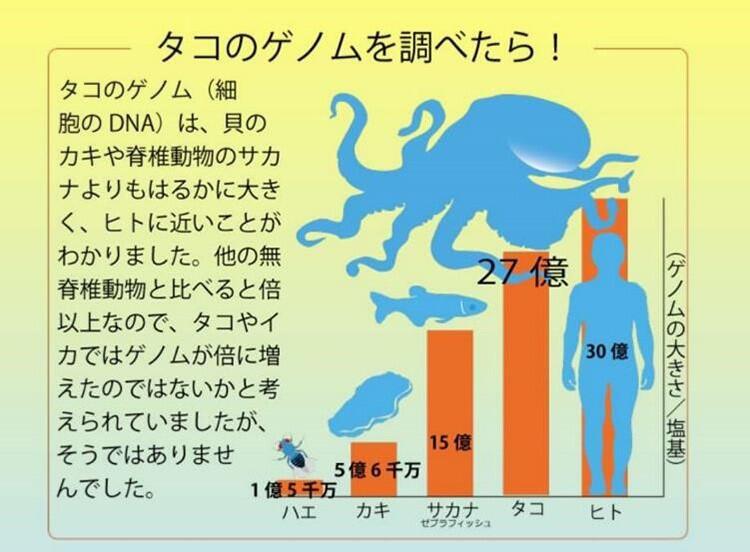
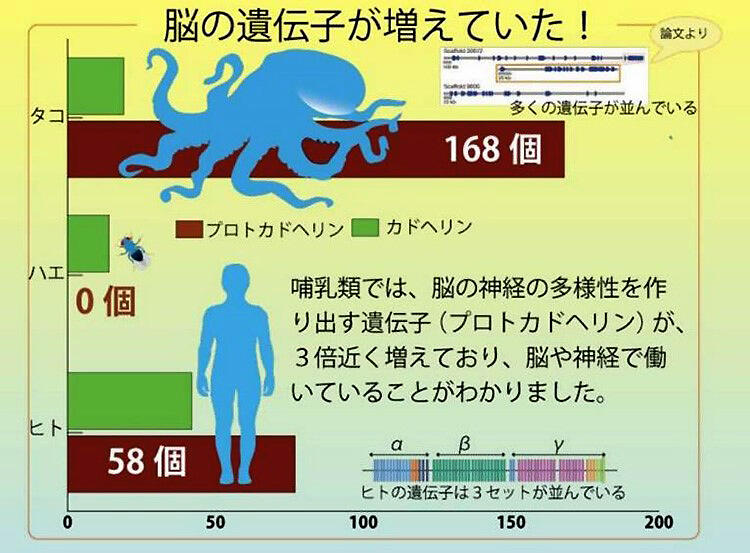
Thanks to evolution, humans quickly acquired interesting abilities that were different from even chimpanzees, their closest relatives. A bipedal gait allows us to do many interesting things. I think the way humans, as living creatures, live and exist, is very interesting. However, when we think of other lifeforms, such as "just octopi," and then we hear that they have a huge number of brain-related genes, we think "what in the world is going on there?"
Yet, that simple curiosity might just give rise to unexpected, even magical, discoveries. When we look at our world (of living things), we should notice that in addition to competition, living things live in a shared world, amidst the warm embrace of one another. Let us use this experience of being forced to live with the coronavirus to our benefit, to choose to live in symbiosis. That is my wish.


NAKAMURA Keiko
Born in 1936 in the city of Tokyo. Graduated from the Department of Chemistry, Faculty of Science, the University of Tokyo in 1959, and completed a graduate degree at the Graduate School of Biochemistry at the same university in 1964. After working as a researcher at the National Institute of Infectious Diseases and the director of the Human Nature Research Department at the Mitsubishi Chemical Life Science Institute, she became a professor at the School of Human Sciences, Waseda University in 1989. In 1995, she served as a visiting professor at the Research Center for Advanced Science and Technology, the University of Tokyo, and in 1996, as a professor at Osaka University. In 2002, she was appointed Director of the JT Biohistory Research Hall, and in 2020, she was appointed Honorary Director. She has written numerous books, from "Life Science" (published by Kodansha) in 1975, to "Life Magazine (Biohistory)" "The Search for New Knowledge Learned over 3.8 Billion Years" (Fujiwara Shoten) in 2017.
(UCHIJO Yoshitaka / Science Portal Editorial Office, Kyodo News Visiting Editorial Writer)
Original article was provided by the Science Portal and has been translated by Science Japan.




